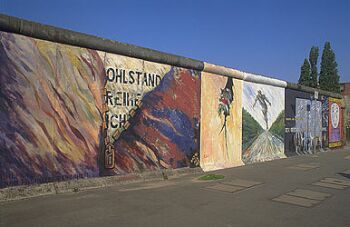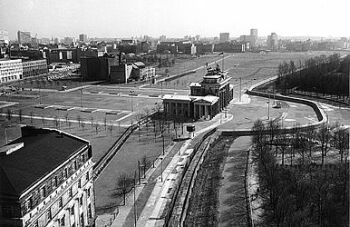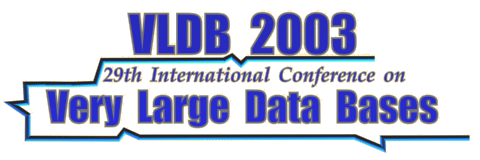|
|
Bernauer Straße
Since 1998 a memorial dedicated to the victims of the wall and the German separation has been situated in Bernauer Straße. The ensemble consists of the memorial of the Berlin wall, a chapel of reconciliation and a centre of documentary. The fallow land of the former "strip of death" is still visible between apartment buildings. This is the only place in Berlin where you can see a complete border area with "Vorderlandmauer", "Kiesstreifen", "Kolonnenweg", "Lichttraße" and "Hinterlandmauer". A plaque reminds of the "separation of the city from August 13th 1961 until November 9th 1989" and "the victims of communist tyranny". In the centre of documentation visitors learn about the construction of the wall with the help of photographies, movies, archives and sound documents. On November 9th, 2000 the chapel of reconciliation was opened in place of the church of reconciliation that was torn down in 1985.
www.berliner-mauer-dokumentationszentrum.de
|
|
Checkpoint Charlie
 The former border between the districts Mitte (East Berlin) and Kreuzberg (West Berlin) was reserved for the Allies. Today a guardhouse and boundary sign, both of them reconstructed, mark the former border in the famous Friedrichstraße. The museum at Checkpoint Charlie tells the story of the wall and escape attemps, visulized by numerous documents.
The former border between the districts Mitte (East Berlin) and Kreuzberg (West Berlin) was reserved for the Allies. Today a guardhouse and boundary sign, both of them reconstructed, mark the former border in the famous Friedrichstraße. The museum at Checkpoint Charlie tells the story of the wall and escape attemps, visulized by numerous documents.
|
East Side Gallery
 While in former times the westside of the Berlin Wall has been a popular meeting point of graffiti sprayers, nowadays the most famous spraying artists have set their signs on the eastside of the longest preserved section of the Wall.
While in former times the westside of the Berlin Wall has been a popular meeting point of graffiti sprayers, nowadays the most famous spraying artists have set their signs on the eastside of the longest preserved section of the Wall.
The largest open air gallery in the world was opened on September 28, 1990. It stretches from Ostbahnhof station to the Oberbaumbrücke. 118 artists from 21 countries have painted diverse pictures on a 1,316 meter long section of the Berlin Wall, which is now a listed landmark. The most famous pictures are "Brotherly Kiss" by Dimitri Vrubel, "Fatherland" by Gunther Schaefer and "Berlin – New York" by Gerhard Lahr. The paintings, whose condition has deteriorated considerably in the last few years, have been restored in 2000.
|
|
Mauerpark
In Mauerpark next to Friedrich-Ludwig-Jahn-Sportpark remains of the wall are integrated in a park. The park is especially popular among teens as those pieces of the wall can leagally be sprayed with graffiti.
www.mauerpark.de
|
|
Brandenburg Gate (Brandenburger Tor)
 Nearby Reichstag white memorial crosses have been put up in rememberance of the wall. In Mai 1989 the bronze sculpture "Der Rufer" created 1967 by Gerhard Marck, was set up in front of Brandenburger Tor.
Nearby Reichstag white memorial crosses have been put up in rememberance of the wall. In Mai 1989 the bronze sculpture "Der Rufer" created 1967 by Gerhard Marck, was set up in front of Brandenburger Tor.
|
|
|


 The former border between the districts Mitte (East Berlin) and Kreuzberg (West Berlin) was reserved for the Allies. Today a guardhouse and boundary sign, both of them reconstructed, mark the former border in the famous Friedrichstraße. The museum at Checkpoint Charlie tells the story of the wall and escape attemps, visulized by numerous documents.
The former border between the districts Mitte (East Berlin) and Kreuzberg (West Berlin) was reserved for the Allies. Today a guardhouse and boundary sign, both of them reconstructed, mark the former border in the famous Friedrichstraße. The museum at Checkpoint Charlie tells the story of the wall and escape attemps, visulized by numerous documents. While in former times the westside of the Berlin Wall has been a popular meeting point of graffiti sprayers, nowadays the most famous spraying artists have set their signs on the eastside of the longest preserved section of the Wall.
While in former times the westside of the Berlin Wall has been a popular meeting point of graffiti sprayers, nowadays the most famous spraying artists have set their signs on the eastside of the longest preserved section of the Wall. Nearby Reichstag white memorial crosses have been put up in rememberance of the wall. In Mai 1989 the bronze sculpture "Der Rufer" created 1967 by Gerhard Marck, was set up in front of Brandenburger Tor.
Nearby Reichstag white memorial crosses have been put up in rememberance of the wall. In Mai 1989 the bronze sculpture "Der Rufer" created 1967 by Gerhard Marck, was set up in front of Brandenburger Tor.